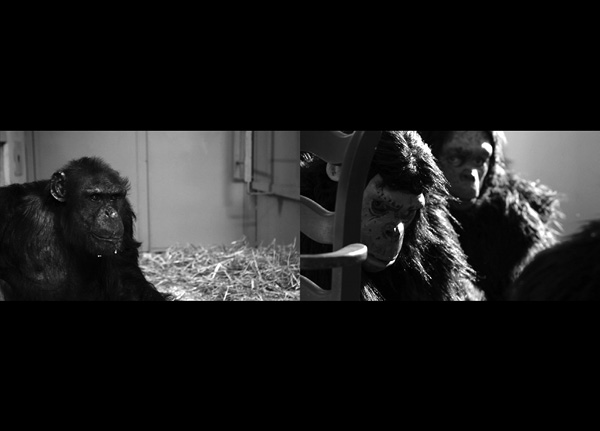
PRIMATE CINEMA: APES AS FAMILY
first performed on
August 9, 2011
Edinburgh Zoo, Edinburgh, Scotland
performed 0 times in 2011
RACHEL MAYERI
Los Angeles, CA
536781127R536781127a536781127c536781127h536781127e536781127l536781127_536781127M536781127a536781127y536781127e536781127r536781127i536781127@536781127h536781127m536781127c536781127.536781127e536781127d536781127u
rachelmayeri.com/projects/primate-cinema
PRIMATE CINEMA: APES AS FAMILY
RACHEL MAYERI
Chimpanzees in captivity watch television as a form of enrichment. What would a show designed expressly for chimpanzees look like? Could we learn something about their mentality by what appealed to them? And then, by watching this interspecies cinema, could we triangulate to learn about how we are similar or different from our primate cousins?
I began by producing and collecting video clips in preparation for a series of test screenings with chimps at the Edinburgh Zoo in collaboration with primatologist Sarah Jane Vick. I grouped scenes of chimpanzee behaviors-foraging and eating, playing, grooming, displaying, hunting, courting, and sex. I shot human actors reenacting some of these behaviors in rudimentary chimp masks and costumes. I collected several human TV genres: World Federation Wrestling, Hell’s Kitchen, Tom and Jerry, E.R., Teletubbies, and kettle drumming.
From the reactions to these tests, I developed a screenplay that would present all of the most spectacular social dynamics of chimp life-primate dramas surrounding sex, food, hierarchy, and territory. The movie, “Apes as Family,” is 21 minutes long and follows an adolescent female chimp who, like chimps in the wild, must leave her family home and make friends in a strange, new community. The protagonist is played by a human actor in a realistic costume, whose facial expressions were puppeted animatronically. The other chimp characters were portrayed either by actors in shaggy bodysuits or as cartoons.
The ape feature premiered in a chimp-proof monitor in the greenery of the zoo as well as in an indoor research pod, which chimps could access voluntarily. The screening was fraught with all sorts of social dynamics. The chimps were often torn between watching the screen and each other. In calmer groups, the chimps watched the show for minutes at a time. Two males displayed in reaction to the climax of the film in which the protagonist meets the strangers, hooting and hitting the screen. Outdoors, the presentation produced such a stir that the gibbons in a nearby enclosure chorused loudly in response. Throughout the project, we learned how chimps’ individual personalities and upbringings-in labs, zoos, or in the wild-affected their responses to television.
“Primate Cinema: Apes as Family” is also a two channel video installation for human primates-the narrative for chimps on one channel and the documentation of the chimps’ reaction on the other. It was screened multiple times over two days for chimps and had several subsequent exhibitions for human beings.